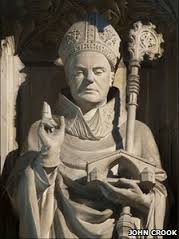
Summary: St Swithun (or Swithin) was an English bishop of Winchester, best known from the popular belief that if it rains on St Swithun’s day, 15th July, it will rain for 40 days and 40 nights.
Patrick Duffy traces St Swithin’s life.
Torrential rain
 The image left<< is of a statue at Stavanger Cathedral, the oldest in Norway.
The image left<< is of a statue at Stavanger Cathedral, the oldest in Norway.
Builder and Restorer of Churches
St Swithun was born in Wessex and spent his youth at the old abbey at Winchester in AD 852. After being ordained, the chroniclers say he was a diligent builder of churches in places where there were none before and a repairer of those that had been destroyed or ruined.
“And if any church fell down, or was in decay, St Swithin would amend it at his own cost. Or if any church were not hallowed, he would go thither afoot and hallow it. For he loved not pride, said ne to riding on gay horses, and ne to being praised and flattered by the people…” The Golden Legend, a medieval book of saints’ stories.
Friend and educator of kings

Egbert, king of Wessex
Egbert, king of Wessex (802-839), chose Swithin as his chaplain and as educator of his son Ethelwulf. Ethelwulf then chose Swithun as bishop of Winchester (852-862) where he helped build the Church and the kingdom of Wessex. He probably also was involved in the education of the young Alfred: he died when Alfred was 13.
At Swithin’s request, Ethelwulf gave a tenth of his royal lands to the Church. Swithun made his diocesan journeys on foot; and when he gave a banquet he invited the poor and not the rich.
Helper of the poor
One day when Swithin was watching workmen building a church on the east side of the city, he saw that an old lady selling a basket of eggs had her eggs smashed by workmen. Swithin picked up the broken eggs and, it is said, they miraculously became whole again.
His death
On his deathbed, Swithin requested that he be buried outside the Old Minster (Cathedral) at Winchester, where “passers by might tread on his grave and where the rain from the eaves might fall on it.” And this was done. St Swithun died on 2nd July 862. He was buried, at his own request, out of doors.
His Translation
But on 15th July 971, Bishop Ethelwold of Winchester had Swithin’s remains dug up and moved to a new shrine inside Stavanger Cathedral. Two contradictory outcomes are traditionally associated with this event. There were so many miraculous cures that Swithin’s feast day became the date of the removal of his remains, and not his death day. But, unfortunately, the removal was also accompanied by ferocious and violent rain storms that lasted 40 days and 40 nights. These are said to indicate the saint’s displeasure at being moved and may be the origin of the legend that if it rains on Saint Swithin’s feast day, the rain will continue for 40 more days.
St Swithun’s day, if thou dost rain,
For forty days it will remain.
St Swithun’s day, if thou be fair,
For forty days ’twill rain nae mair.